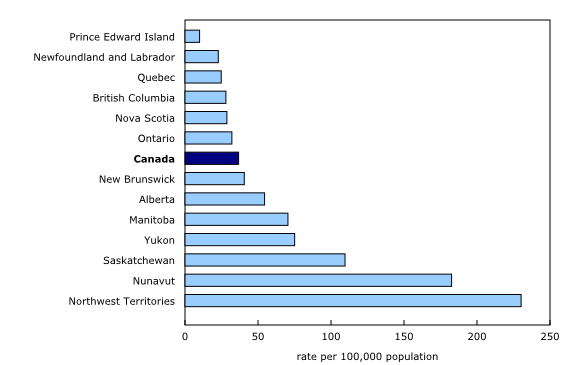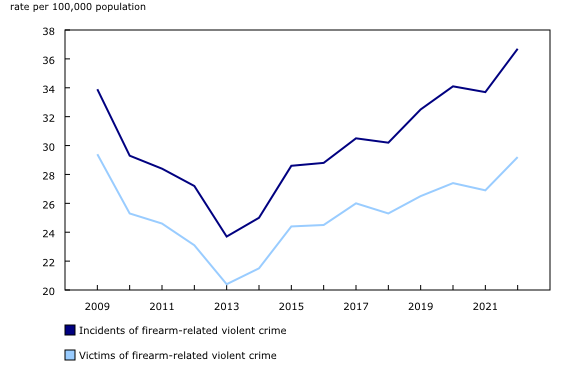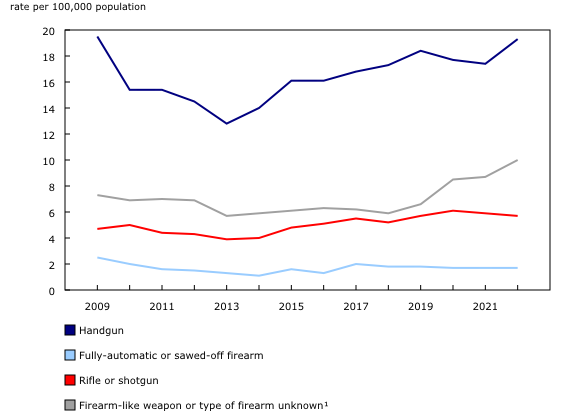Firearms and violent crime in Canada, 2022
Released: 2024-01-30
In 2022, slightly less than 3% of police-reported violent crimes in Canada (or approximately 14,000 violent crimes) involved a firearm. This corresponds to a rate of 36.7 firearm-related violent crimes per 100,000 population, an increase of 8.9% from the 2021 rate. The 2022 rate of firearm-related violent crime is the highest since comparable data were first compiled in 2009.
The Juristat article "Firearms and violent crime in Canada, 2022," published today, presents the most recent police-reported data on firearm-related violent crime in Canada, based on the Uniform Crime Reporting Survey and the Homicide Survey.
The increase in the firearm-related crime rate is largely driven by an increase in these crimes in Ontario
Police services in Ontario reported 4,791 firearm-related violent crimes in 2022, or 1,016 more incidents than the previous year. This represents about 70% of the increase in these incidents across Canada. The 2022 rate of firearm-related violent crime in Ontario (32.1 incidents per 100,000 population) was 24% higher than the previous year's rate.
The increase in firearm-related violent crime in Ontario was largely driven by an increase in the number of these crimes in Toronto. Although almost all census metropolitan areas (CMAs) in Ontario saw an increase in firearm-related violent crime, the increase in the number of these crimes was especially high in Toronto. After three consecutive yearly declines, police services covering the Toronto CMA reported 2,576 firearm-related violent crimes, 725 more than in 2021. As a result, the 2022 rate (43.2 incidents per 100,000 population) was 36% higher than in 2021. Among Ontario CMAs, only Greater Sudbury (+65%), Kitchener–Cambridge–Waterloo (+53%) and Brantford (+39%) posted bigger increases in the rate of firearm-related violent crimes.
British Columbia and Alberta also contribute to the increase in the number of firearm-related violent crimes
British Columbia also contributed to the increase in the number of firearm-related violent crimes in Canada. In 2022, police reported close to 1,500 firearm-related violent crimes, almost 200 more than in the previous year. The rate (28.0 incidents per 100,000 population) was up 12% from 2021, but remains one of the lowest rates among the provinces and territories. The increase in the rate from 2021 was especially large in Abbotsford–Mission (+72%), though Victoria (+63%) and Vancouver (+24%) also posted significant increases.
In 2022, Alberta (54.5 incidents per 100,000 population) also recorded close to 200 more firearm-related violent crimes than in 2021. As in Ontario and British Columbia, this increase was mostly driven by the largest urban centres, with the rate increasing by 22% in Edmonton and by 5.1% in Calgary during this period.
In New Brunswick, police recorded 64 more incidents of firearm-related violent crime in 2022 than in 2021. The rate of firearm-related violent crime (40.6 incidents per 100,000 population) was up 24%, the second highest increase among the provinces and territories. The rate rose by 46% in Moncton during this period.
In Manitoba, the Northwest Territories, Yukon and Prince Edward Island, the number of firearm-related violent crimes rose slightly from 2021. For their part, some CMAs posted strong increases despite a decrease in their province. For example, Gatineau (+76%) saw the highest increase in firearm-related violent crime among the CMAs in 2022, while this rate decreased slightly in Quebec (-1.3%).
Despite a 7.0% decrease in firearm-related violent crimes from 2021, Saskatchewan continued to be the province with the highest rate in 2022 (109.6 incidents per 100,000 population). Among the country's CMAs, Regina posted the highest rate (83.0) and percentage (7.0%) of firearm-related violent crime.
The rate of firearm-related violent crime has generally been increasing since 2013, with the increase higher in rural areas
The increase in firearm-related violent crimes in 2022 is the continuation of an upward trend that began in 2013. Since then, the rate of firearm-related violent crime has increased 55%, which is larger than the increase in violent crime overall (+24%).
Although the increase in firearm-related violent crime from 2021 to 2022 was mostly driven by increases in urban areas in the Provincial South, it was rural and northern regions that largely contributed to the increase from 2013 to 2022. For example, from 2013 to 2022, the rate of firearm-related violent crime increased 141% in rural regions of the Provincial North and 139% in the territories. By comparison, in southern urban areas, the rate increased by 45%.
Strong increase in incidents involving discharging a firearm with intent
Compared with 2013, the rate of firearm-related violent crime in 2022 was higher for most violent offences. In particular, firearm-specific violent crimes (discharging a firearm with intent, pointing a firearm, using a firearm in the commission of an offence) rose 120% from 2013 to 2022, primarily because of the increase in incidents of discharging a firearm with intent, the rate of which has more than tripled (+244%) since 2013.
The homicide rate has increased 64% since 2013. In 2022, police reported 874 homicides, 342 of which were committed with a firearm. This was 44 more homicides committed with a firearm than in the previous year, and 208 more homicides committed with a firearm than in 2013. The rate of firearm-related homicide in 2022 (0.88 homicides per 100,000 population) was the highest rate since 1991.
The rate of handgun-related violent crime has increased by half since 2013
Since 2013, the rate of firearm-related violent crime has risen for all types of weapons. However, the increase was larger for crimes involving handguns (+50%) than for crimes involving rifles or shotguns (+45%) or for those involving fully automatic or sawed-off firearms (+35%). However, the category "firearm-like weapon or unknown type of firearm" posted the largest increase (+76%).
Did you know we have a mobile app?
Get timely access to data right at your fingertips by downloading the StatsCAN app, available for free on the App Store and on Google Play.
Note to readers
The data in this article are mostly from the Incident-based Uniform Crime Reporting Survey (UCR2) trend database. Coverage of the UCR2 Survey for the period from 2009 to 2022 is estimated at 99% of the Canadian population. Only police services that have consistently participated in the UCR2 Survey are included so that comparisons can be made over time. In this article, data from the Service de police de la Ville de Québec are excluded due to concerns about the data quality for the variable "most serious weapon present." Analyses based on the UCR2 trend database also exclude data from the Saint John Police Force. Data on homicides are derived from the Homicide Survey, which has collected police-reported data on the characteristics of all homicide incidents, victims and accused persons in Canada since 1961.
For the purposes of this analysis, a firearm-related violent crime refers to a crime where a firearm was present during the commission of the offence and police determined that the firearm was relevant to the crime, whether or not it was used. Crimes involving a firearm-like weapon, such as an imitation weapon or a pellet gun, are also included in the analysis. Firearm-specific offences—such as discharging a firearm with intent, pointing a firearm and using a firearm during the commission of an offence—are also counted as crimes involving firearms, including cases in which information on the weapon was unknown. The number of incidents corresponds to the number of victims, in addition to the crimes for which the police did not provide a victim record. One incident may involve multiple offences. To ensure data comparability, the figures in this article are based on the most serious offence in the incident. Firearm-related crime data released in the past were generally based on the number of victims rather than the number of incidents; these data can therefore differ slightly from the data in this article.
For the purposes of the UCR Survey and the Homicide Survey, the different types of firearms are (presented in descending order of seriousness according to the hierarchy for determining the most serious weapon):
Fully automatic firearm: Any firearm that allows continuous and rapid firing of bullets with one pull of the trigger.
Sawed-off rifle or shotgun: Any rifle or shotgun with a barrel length that has been altered to less than 457 millimetres or with an overall weapon length of less than 660 millimetres.
Handgun: Any firearm designed to be held and fired by the action of one hand.
Rifle or shotgun: Any long-barrelled firearm with a barrel length equal to or greater than 457 millimetres or with an overall length of 660 millimetres or more.
Firearm-like weapon: Any weapon capable of propelling any object through a barrel by means of gunpowder, compressed carbon dioxide, pumped air, or any other means. Includes, for example, flare guns or pellet guns. For UCR data, this category also includes all unknown types of firearms.
In Quebec, the information management system used by most police services produces a relatively high proportion of unknown values for the variable "most serious weapon present." For this reason, Quebec data were excluded from previous articles on firearm-related violent crime. However, subsequent analyses have shown that this issue has no significant effect on reporting firearm-related crimes, and the data in this article include those for Quebec. Nonetheless, caution should be exercised when comparing Quebec data with data from the other provinces or territories.
Products
The article "Firearms and violent crime in Canada, 2022" is now available as part of the publication Juristat (85-002-X).
Contact information
For more information, or to enquire about the concepts, methods or data quality of this release, contact us (toll-free 1-800-263-1136; 514-283-8300; infostats@statcan.gc.ca) or Media Relations (statcan.mediahotline-ligneinfomedias.statcan@statcan.gc.ca).
- Date modified:



